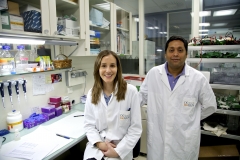
2014/03/26
Abnormal levels of a molecule are associated with diabetic neuropathy
- Researchers from CIC bioGUNE have revealed that the molecule SAMe causes changes in the genome that affect the peripheral nervous system
- Diabetic neuropathy affects between 60% and 70% of diabetes sufferers
- The study led by Dr. Ashwin Woodhoo has recently been published in the prestigious journal Neuron
(Bilbao, March 2014).- A study led by the Basque bioscience research centre CIC bioGUNE has revealed that abnormal levels of a molecule known as SAMe could be one of the factors involved in the onset of diabetic neuropathy, a disorder suffered by between 60% and 70% of diabetes patients and which, according to the International Diabetes Foundation (IDF), affects around 400 million worldwide. The conclusions of this study may also be applicable to diseases such as Alzheimer's disease.
The research, which was led by the CIC bioGUNE researcher Ashwin Woodhoo and was recently published in the prestigious US journal Neuron, could represent an important step towards understanding the origin and evolution of neuropathies. Diabetic neuropathy is highly prevalent amongst diabetes patients. However, although some people with nerve damage do not present symptoms, in others it can be highly debilitating due to the pain and sensory and motor disorders that can occur in various parts of the body.
In this study, which was conducted in mice, it was found that damage to the peripheral nervous system occurred in the presence of abnormal levels of the molecule SAMe (S-adenosyl methionine). Abnormal levels of this molecule in body result in changes to genome function, which in turn affect the development and correct functioning of the peripheral nervous system.
Specifically, these changes cause defects in myelin, a fatty sheath that covers the neuronal axons and aids the transmission of nerve impulses. Such myelin defects lead to neuropathies.
Diabetic neuropathy affects the peripheral nervous system, which comprises nerves and neurons that connect the limbs and organs in the body to the central nervous system, which itself comprises the brain and spinal cord. The peripheral nervous system is responsible for coordinating, regulating and integrating our organs by way of voluntary and involuntary responses.
The symptoms provoked by this disease include pain, tingling or loss of sensation in the limbs and problems in the digestive system or sex organs. It is the most common diabetes-related disorder.
Diabetes, certain eating habits or a viral infection may all cause abnormal SMAe levels. This molecule participates in a chemical process known as methylation, which induces changes in the genome that cause certain genes to "switch on" or "switch off". SAMe may be responsible for regulating the expression of genes involved in the development and functioning of myelin. Abnormal levels of SAMe cause defects in myelin and, therefore, in nerve impulse transmission, thus leading to the onset of neuropathies.
"Our aim was to analyse the regulatory role of DNA methylation in the development and correct functioning of the nervous system", states CIC bioGUNE researcher Ashwin Woodhoo, who led the study and has recently been appointed an Ikerbasque Research Fellow. "Our work is completely novel in this field as we provide evidence regarding the role of DNA methylation during the myelination process and sheds new light on the possible mechanisms that could contribute to the pathogenesis of acquired peripheral neuropathies", concludes Woodhoo.
Moreover, as noted by CIC bioGUNE researcher Marta Iruarrizaga-Lejarreta, who also participated directly in the project, "the conclusions of our study could also be extended to other diseases, such as Alzheimer's disease, in which changes to DNA methylation patterns have been described and, in addition, decreased SAMe levels have been found in the cerebrospinal fluid of patients with this disease". As such, according to Iruarrizaga, "this work may be of great interest as regards making further progress in the search for possible mechanisms involved in the development of neuropathies as well as other neurodegenerative diseases".
CIC bioGUNE has conducted this study in collaboration with the CIBERehd Networked Biomedical Research Centre (Barcelona), the University Institute of Oncology at the University of Oviedo (IUOPA-HUCA), the Bellvitge Biomedical Research Institute - IDIBELL (Barcelona), University College London, Vanderbilt University in Tennessee (USA) and the University of Southern California (USA).
The RRBS technique, a high-throughput technology used to analyse DNA methylation throughout the genome, has been used in this study.
About CIC bioGUNE
The Center for Cooperative Research in Biosciences (CIC bioGUNE) is a biomedical research organisation established by the Basque Government's Department of Industry in 2002. The main goal of this body, which is located at the Bizkaia Technology Park, is to make progress in basic research in the field of bioscience.
About the researchers
Dr. Ashwin Woodhoo is a postdoctoral researcher in the group headed by Prof. José María Mato in the Metabolomics Unit at CIC bioGUNE. Dr. Woodhoo obtained his doctorate from University College London (UCL) and joined CIC bioGUNE in 2009. His research projects are funded by the Carlos III Health Institute (Ministry of Health), the AECC science foundation (sponsored by the Bizkaia Provincial Board), the Basque Government's Department of Education and the Royal Society (London). He has also been awarded grants from the Ministry of Finance (Juan de la Cierva and Ramón y Cajal contracts) and was recently appointed an Ikerbasque Research Fellow.
Marta Iruarrizaga-Lejarreta obtained her undergraduate degree from the University of the Basque Country (UPV/EHU) and is currently undertaking her doctoral studies in the Metabolomics Unit at CIC bioGUNE under the supervision of Dr. Ashwin Woodhoo.
See a large version of the first picture





